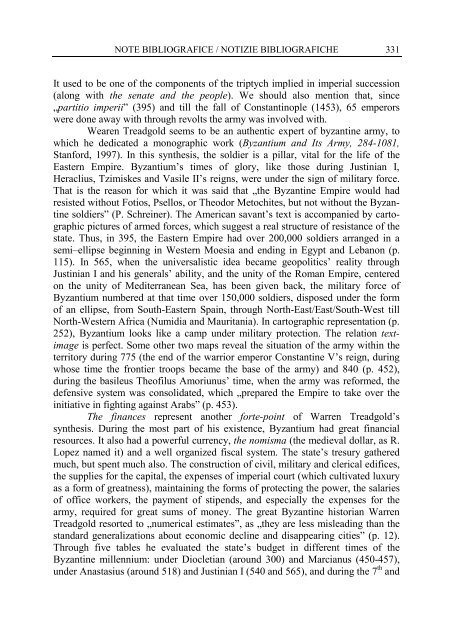Facultatea de Istorie - Universitatea Alexandru Ioan Cuza
Facultatea de Istorie - Universitatea Alexandru Ioan Cuza
Facultatea de Istorie - Universitatea Alexandru Ioan Cuza
You also want an ePaper? Increase the reach of your titles
YUMPU automatically turns print PDFs into web optimized ePapers that Google loves.
NOTE BIBLIOGRAFICE / NOTIZIE BIBLIOGRAFICHE 331<br />
It used to be one of the components of the triptych implied in imperial succession<br />
(along with the senate and the people). We should also mention that, since<br />
„partitio imperii” (395) and till the fall of Constantinople (1453), 65 emperors<br />
were done away with through revolts the army was involved with.<br />
Wearen Treadgold seems to be an authentic expert of byzantine army, to<br />
which he <strong>de</strong>dicated a monographic work (Byzantium and Its Army, 284-1081,<br />
Stanford, 1997). In this synthesis, the soldier is a pillar, vital for the life of the<br />
Eastern Empire. Byzantium’s times of glory, like those during Justinian I,<br />
Heraclius, Tzimiskes and Vasile II’s reigns, were un<strong>de</strong>r the sign of military force.<br />
That is the reason for which it was said that „the Byzantine Empire would had<br />
resisted without Fotios, Psellos, or Theodor Metochites, but not without the Byzantine<br />
soldiers” (P. Schreiner). The American savant’s text is accompanied by cartographic<br />
pictures of armed forces, which suggest a real structure of resistance of the<br />
state. Thus, in 395, the Eastern Empire had over 200,000 soldiers arranged in a<br />
semi–ellipse beginning in Western Moesia and ending in Egypt and Lebanon (p.<br />
115). In 565, when the universalistic i<strong>de</strong>a became geopolitics’ reality through<br />
Justinian I and his generals’ ability, and the unity of the Roman Empire, centered<br />
on the unity of Mediterranean Sea, has been given back, the military force of<br />
Byzantium numbered at that time over 150,000 soldiers, disposed un<strong>de</strong>r the form<br />
of an ellipse, from South-Eastern Spain, through North-East/East/South-West till<br />
North-Western Africa (Numidia and Mauritania). In cartographic representation (p.<br />
252), Byzantium looks like a camp un<strong>de</strong>r military protection. The relation textimage<br />
is perfect. Some other two maps reveal the situation of the army within the<br />
territory during 775 (the end of the warrior emperor Constantine V’s reign, during<br />
whose time the frontier troops became the base of the army) and 840 (p. 452),<br />
during the basileus Theofilus Amoriunus’ time, when the army was reformed, the<br />
<strong>de</strong>fensive system was consolidated, which „prepared the Empire to take over the<br />
initiative in fighting against Arabs” (p. 453).<br />
The finances represent another forte-point of Warren Treadgold’s<br />
synthesis. During the most part of his existence, Byzantium had great financial<br />
resources. It also had a powerful currency, the nomisma (the medieval dollar, as R.<br />
Lopez named it) and a well organized fiscal system. The state’s tresury gathered<br />
much, but spent much also. The construction of civil, military and clerical edifices,<br />
the supplies for the capital, the expenses of imperial court (which cultivated luxury<br />
as a form of greatness), maintaining the forms of protecting the power, the salaries<br />
of office workers, the payment of stipends, and especially the expenses for the<br />
army, required for great sums of money. The great Byzantine historian Warren<br />
Treadgold resorted to „numerical estimates”, as „they are less misleading than the<br />
standard generalizations about economic <strong>de</strong>cline and disappearing cities” (p. 12).<br />
Through five tables he evaluated the state’s budget in different times of the<br />
Byzantine millennium: un<strong>de</strong>r Diocletian (around 300) and Marcianus (450-457),<br />
un<strong>de</strong>r Anastasius (around 518) and Justinian I (540 and 565), and during the 7 th and


